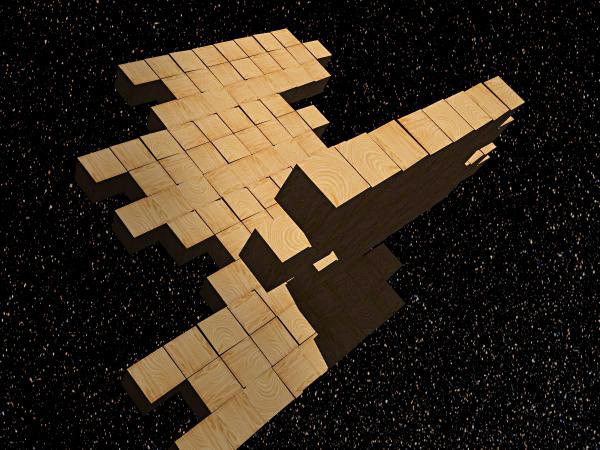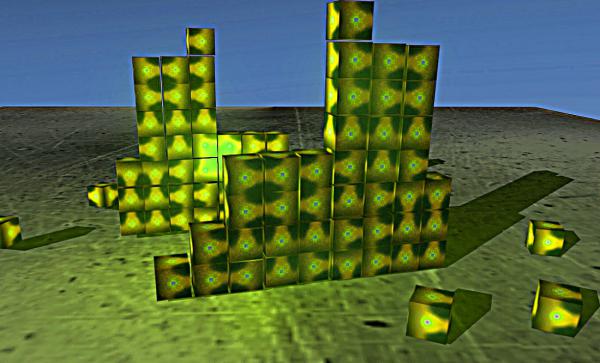BY LETTER
Dittocubes
Clarketech devices capable of self-replication. | |
 Image from Steve Bowers | |
| The Sco-Cen dittocube duplicating in a vacuum | |
Dittocubes are a class of clarketech devices, mostly of unknown origin. Several different types have been recovered from a variety of locations, each with unique characteristics.
A dittocube takes the form of a regular cube which has the power to duplicate itself when ordered to do so. Responding to spoken commands, DNI communications or more complex blueprints in various formats. The cube will periodically double in size creating copies of itself along all three axes, remaining connected to the original cube, then branching out and forming structures of varying levels of complexity (ladders, bridges, columns, archways, shacks, warehouses, cathedrals), all formed from cubes identical and remaining connected to the original unless instructed otherwise.
One famous type of dittocube, discovered in 7666 AT in the Sco-Cen OB Association, is approximately 1.3125 centimeters to a side, with rounded edges and corners. The texture resembles that of natural wood, and it resembles a child's old-fashioned wooden building block. Other dittocubes are smaller or larger have elaborate patterns on their surface, and some glow with curious colors when in operation. Only static structures can be produced. No complex machines with moving parts, or structures requiring angles greater or less than 90 degrees can be formed (though other angles or continuous curves can be approximated on a large scale by many small duplicate cubes). One potential use for dittocubes is the construction of large habitable structures, either on a planetary surface or in space; the strongest dittocubes form structures with a material strength comparable to diamondoid, and a small number of habs have been constructed in this way.
Dittocubes can be classified according to their observed characteristics. The simplest cubes appear to be copies, or perhaps fakes, constructed by modosophonts using advanced nanotechnology (sometimes at ultratech level). These objects duplicate themselves by scavenging materials from the environment using microscale robots or branching rootlike structures; the scavenged material can be easily detected as it is brought back to the cube. Such devices are not classed as clarketech, although they are valuable in their own right; they are relatively simple modular construction tech, but most examples can replicate autonomously with minimal oversight.
A more advanced and rare form of Dittocube is capable of very fast self-replication in extreme environments such as stellar surfaces, the cores of fusion reactors and high temperature accretion disks. The exact method of replication is not known, but it is believed to involve magmatter in some way. Such cubes start off extremely dense but get less dense as they replicate, which seems to confirm the magmatter hypothesis.
Prime Dittocubes
The rarest type of dittocube, known as the Prime Dittocube, operates on principles that are as yet unknown, although there are several competing hypotheses. These cubes appear to double in mass and volume without any physical input whatever. The Sco-Cen dittocube is alleged to be one such example; long ago its current owners (The Alexandian Institute) placed it inside a carefully guarded normal matter shell away from observers. Some commentators have speculated that the Institute had ordered it to grow as much as possible to see how large it could get. It is possible that the cube ceased to duplicate itself before it became massive enough to collapse under its own weight, but the Institute have declined to confirm this.According to transapient/archailect informants the most advanced/clarketech versions of the cubes only seem to violate conservation of matter/energy but do not in fact do so; their explanations of how this can be so are not entirely comprehensible and consistent, so a number of hypotheses have been put forwards by modosophont researchers to explain the cube's characteristics. Early ideas suggested that it absorbed sunlight or other electromagnetic radiation and converted it to mass, but the cube was shown to be capable of duplication even when isolated from the outside universe. Another idea was that it absorbed vacuum phase energy from empty space, but this has been convincingly demonstrated to be impossible even for the most advanced godtech; similarly the idea that the cube used quantum tunneling to suck mass-energy from elsewhere in the universe, or even from nearby branes has also been dismissed.
The most promising hypothesis is that the cube contains an unknown number of Void Pockets, each containing some number of secondary dittocubes. Whenever the prime cube duplicates itself a void pocket emerges from it (either through very small exits or by passing between the atoms), and moves into position relative to the prime cube and then deactivates. Inside each void pocket is secondary cube which orients itself according to the user's instructions. Since a void pocket can be measured in nanometers, the prime dittocube could potentially contain a vast number of sub-cubes. And because void pockets (like other forms of void bubble) can propel themselves using metric technology the prime cube could have a very large intrinsic mass yet appear to weigh very little.
Although there is no direct confirmation, there are rumors that some dittocubes have additional capabilities which can be 'unlocked' by solving certain puzzles. According to these tales the cubes can be persuaded to unfold to form a wide range of surfaces using one of the various forms of extensible matter. Codes or secret instructions have allegedly been discovered which when given to the cubes cause them to spontaneously grow into certain insane shapes, and dynamically alter themselves for unknown reasons; these patterns are being studied in an attempt to get an insight into godtech.
The origin/designer of the Prime dittocube is unknown at present time, and its intended purpose is also unknown. Speculation ranges from advanced construction device to an actual toy for immature archai. The mass of a Prime dittocube is indeterminate: such a cube may suspend itself in a gravity field, apparently weightless, an observation that appears to support the void bubble hypothesis.
 Image from Steve Bowers | |
| Dittocubes in the Gwight collection | |
Apart from the Sco-Cen cube, there are rumors of a number of other Prime Dittocubes from various locations, each with slightly different behaviors and characteristics. Evan Gwight, the famous Clarker from New Brooklyn, is believed to have a Prime cube in his possession; he occasionally gives a secondary cube away, which glows with a curious yellow-green light, but the glow fades as soon as the recipient carries it away from the primary; such a cube cannot replicate and has little more than novelty value.
Related Articles
Appears in Topics
Development Notes
Text by Mike Parisi
Steve Bowers, Todd Drashner, Ryan B, Stephen Inniss
Initially published on 18 June 2002.
Steve Bowers, Todd Drashner, Ryan B, Stephen Inniss
Initially published on 18 June 2002.






